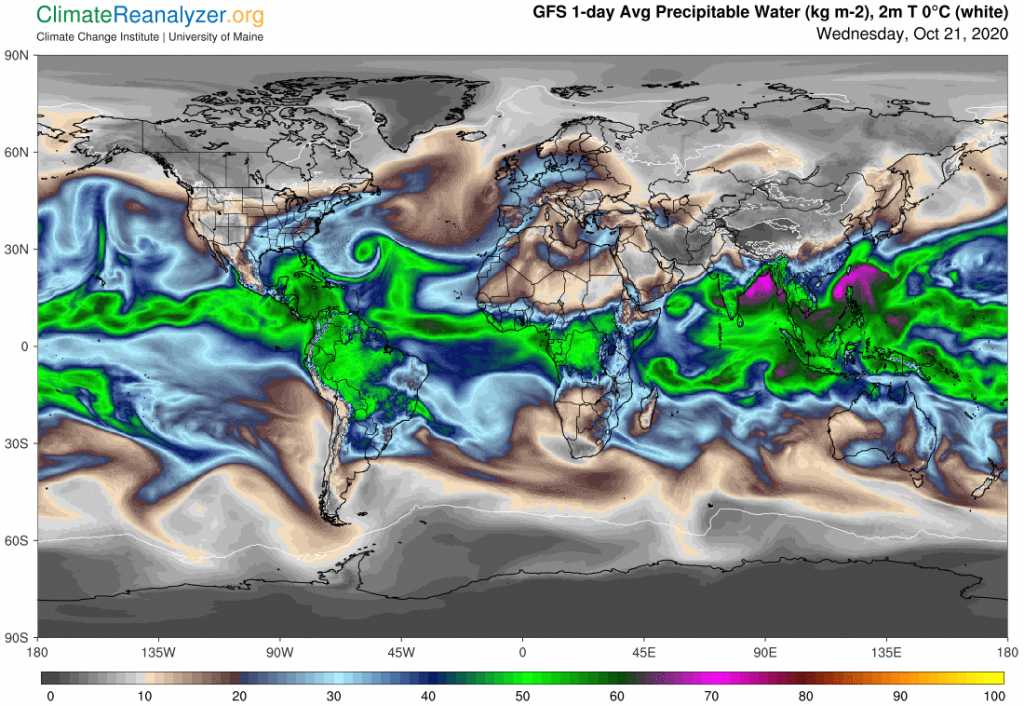I need to show the progress of the Arctic polar heatwave today. It is just as strong and massive as before but the positioning has shifted a little and so has the main geographical source of energy supply. The principal source is still in the form of abnormal inputs of high-altitude water vapor, as it always has been, but now the largest volume is entering the polar zone from the opposite side of the ocean from where it did earlier. This view of the anomaly area is of extra interest because it ultimately reveals an unbroken mass of warmth that extends for about 8000 miles from tip to toe, north to south. (I am not yet confident about how well the computer system will be preserving new images from the Weather Map site. There is a bad link somewhere that I am so far unable to find or correct, a real shame because having these map comparisons in hand over time could provide a record of value for future students.)

The best view of water vapor coverage over all portions of the anomaly is the one on a full global map. Here you can compare inputs from several sources into the polar zone, with the source out of eastern Siberia being the clear winner. Also note the way Antarctica is being subjected to four strong approaches of streams that are now boosted by seasonal changes but are still unable to make deep penetration into the polar zone. The fact that the vapor streams we watch all have a common “mindset” urging them to reach the pole, just like Scott, Amundsen, Peary and the rest, is simply an every day reality, whether or not you can explain it. The fact that only a few reach the “target” is also a reality. There are reasons of a physical type, worth investigating, for why some quantities of vapor can make deep penetration of the two polar zones while others cannot. Those that succeed invariably have an effect on air temperatures—on the warm side. We don’t ever read about this in scientific studies, and can even wonder whether there is anyone interested.

James Hansen has been a preeminent climate scientist for almost half a century. A book he wrote, Storms of My Grandchildren (2009), is what inspired me to start learning more about climate science, only eight years ago, soon followed by the early version of this newsletter. Everything Dr. Hansen writes is interesting and often provocative. There is one short piece he wrote just this month, available at https://mailchi.mp/caa/accelerated-global-warming, that is certainly timely, and quite interesting in several ways—except that his conclusion about water vapor does nothing more than reflect a standard mainstream stereotype. There is an unquestioned dogma maintaining that the power of water vapor as a greenhouse gas is limited by the airborne volume of vapor that is in place, and that any increase in volume is aligned with and limited by increases in air temperature. Since water vapor’s volume is thus taken to exist only as a feedback derived from increased air temperatures it must not be treated as one of the forces that act as an original cause for those increases. (Water vapor’s strength, of course, is in part accounted for by limited secondary effects due to the regular warming it produces as its volume grows.)
An alternative viewpoint would look beyond the total volume of water vapor in the atmosphere and take the effects of its unusual overall distribution into account. Some amount of new evaporation is always finding its way (by means that do not look closely regulated) into the upper level wind system of either hemisphere, where the freedom of movement appears to be possibly more expansive than it is for vapor that remains in other venues. Also, with the direction of movement dominated by advances toward either pole, the vapor that exists in this situation, if not restricted, can become well-positioned for having magnified greenhouse powers when traveling over areas that produce less and less moisture of their own near the surface. Surface air that is warmed in this manner gains the capacity to absorb and hold more water vapor than otherwise by itself, for a minor amplifying effect.
Carl